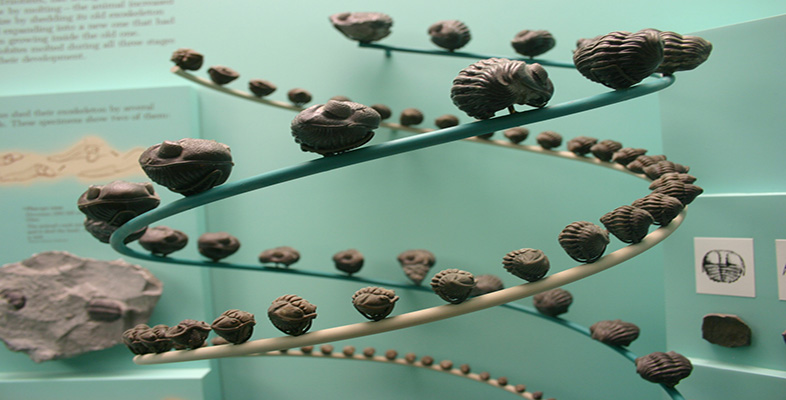6 Vertebrates move onto land
6.1 A difficult evolutionary transition
Before going any further, click on 'View document' below and read pages 78-79 and 82-83 from Douglas Palmer's Atlas of the Prehistoric World.
View document [Tip: hold Ctrl and click a link to open it in a new tab. (Hide tip)]
As we saw in Section 3, the move out of water on to land was a particularly difficult evolutionary transition, requiring many adaptations.
SAQ 16
What specific adaptations did vertebrates evolve for living on land, and why were they needed?
Answer
Muscular limbs that lift the body and propel it forward, as movement on land could not easily be achieved with fish-like fins (note that limbless snakes today can move over land, though the skeletons of some snakes retain internal vestiges of limbs possessed by their ancestors); internal lungs, as the gills of fish collapse out of water; 'ears' to hear sound in air as opposed to water; and moist eyes and skin to prevent them drying up in air (Atlas, pp. 78-79).
The earliest four-limbed vertebrates (i.e. tetrapods) are known from late Devonian river and lake deposits in Greenland. Acanthostega and Ichthyostega have a somewhat puzzling mixture of characteristics. They have four jointed, muscular limbs that were originally interpreted as legs for living on land, but they also have long, sideways-flattened, fish-type tails for swimming, a sensory system for detection of vibrations in water and, most important, fish-type gills. The current interpretation therefore sees the limbs as adaptations for life in a particular aquatic environment rather than for life on land. However, these limbs also had very appropriate preadaptations for the tetrapod descendants who did leave the water. By the early Carboniferous, limbs with five digits had become the norm, which has remained so ever since.
SAQ 17
Look at the panorama on pp. 78-79 of the Atlas. How many digits ('fingers' or 'toes') did Acanthostega and Ichthyostega have on each limb?
Answer
Acanthostega had eight digits, Ichthyostega had seven or possibly eight digits.
SAQ 18
What were the earliest tetrapod limbs supposedly used for in this late Devonian aquatic environment?
Answer
The muscular limbs, hands and feet were used for additional propulsion (aiding the fish-like tail), for holding on to plants and perhaps digging for shellfish (Atlas, p. 78).
By early Carboniferous times, fossils from localities such as East Kirkton in Scotland reveal the existence of several different tetrapod groups (Atlas, pp. 82-83). Some of these were still fully aquatic, but others, such as the superficially lizard-like Westlothiana and the salamander-like Balanerpeton, had probably made the transition to a semi-aquatic life. Life in the water was hazardous, with intense competition for food, and one of the selection pressures favouring early tetrapods leaving the water may have been the chance to exploit the abundant food resources on land. However, life on land could also be dangerous, as witnessed, for example, by the scorpion, Pulmonoscorpius, which grew up to 70 cm long.
You might wonder why the word 'tetrapod' is used here instead of amphibian or reptile. Certainly, modern tetrapods are clearly separated into amphibians, reptiles, birds and mammals, largely on the basis of their distinctive reproductive systems. Amphibians breed in water, where they lay unprotected eggs which are externally fertilised. By contrast, reptiles, birds and mammals use internal fertilisation. In reptiles and birds, the embryo develops in fluid surrounded by a protective shell - an egg that can be laid on land. In nearly all mammals, the developing embryo is also surrounded by fluid and a protective membrane, but is retained in the mother's body for some time before birth. Such protective membranes are not confined to the mammals but are also found in reptiles and birds, all of which are grouped as amniotes. The amniotes are therefore more independent of water than amphibians whose embryos are not protected by such membranes and therefore have to develop in water. The problem is that the early tetrapod fossils do not preserve direct evidence of reproductive habits. Also, during early tetrapod evolution there would not have been so clear a separation between amphibians and reptiles as we find today. Only later, when clearly identifiable amphibian or reptilian characteristics emerge in the fossils, is classification easier.
By Carboniferous times terrestrial food chains were already well developed with a great variety of plants such as tree-sized clubmosses, seed plants and tree ferns and smaller, ground-covering ferns. These plants supported a wide variety of invertebrate life, including many arthropods, which provided abundant food for the carnivorous land-living tetrapods.
